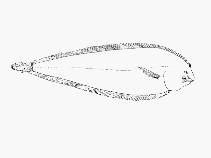Austroglossus microlepis (Bleeker, 1863)
West coast sole
إضافة ملاحظاتك Fish Watcher
| Native range | All suitable habitat | Point map | Year 2050 |

|
| This map was computer-generated and has not yet been reviewed. |
| Austroglossus microlepis AquaMaps Data sources: GBIF OBIS |
ارفع صور و مقاطع فيديو
Pictures | صور قوقلAustroglossus microlepis
Picture by SFSA
Pictures | صور قوقلAustroglossus microlepis
Picture by SFSA
South Africa country information
Common names:
Weskus-tongvis, West coast sole
Occurrence: native
Salinity: marine
Abundance: | Ref:
Importance: commercial | Ref: Heemstra, P.C. and O. Gon, 1986
Aquaculture: | Ref:
Regulations: | Ref:
Uses: no uses
Comments: Ranges from the west coast south to False Bay.
National Checklist:
Country Information: https://www.cia.gov/library/publications/resources/the-world-factbook/geos/sf.html
National Fisheries Authority:
Occurrences: Occurrences Point map
Main Ref: Heemstra, P.C. and O. Gon, 1986
National Database:
Occurrence: native
Salinity: marine
Abundance: | Ref:
Importance: commercial | Ref: Heemstra, P.C. and O. Gon, 1986
Aquaculture: | Ref:
Regulations: | Ref:
Uses: no uses
Comments: Ranges from the west coast south to False Bay.
National Checklist:
Country Information: https://www.cia.gov/library/publications/resources/the-world-factbook/geos/sf.html
National Fisheries Authority:
Occurrences: Occurrences Point map
Main Ref: Heemstra, P.C. and O. Gon, 1986
National Database:
Common names from other countries
التصنيف / Names الأسماء الشائعة | مرادفات | Catalog of Fishes(جنس, الانواع) | ITIS | CoL | WoRMS | Cloffa
> Pleuronectiformes (Flatfishes) > Soleidae (Soles)
Etymology: Austroglossus: Composed from Austro = the south + Greek, glossa = tongue (Ref. 45335).
More on author: Bleeker.
Etymology: Austroglossus: Composed from Austro = the south + Greek, glossa = tongue (Ref. 45335).
More on author: Bleeker.
Environment: milieu / climate zone / depth range / distribution range البيئة
بحري قاعية المعيشة; نطاق العمق 100 - 400 m (Ref. 5304). Deep-water; 17°S - 35°S, 10°E - 25°E
التوزيع دول | مناطق الفاو | النظام البيئي | الظهور | Point map | مقدمة | Faunafri
Southeast Atlantic: northern Namibia to False Bay, South Africa.
الحجم / وزن / العمر
Maturity: Lm ? range ? - ? cm
Max length : 75.0 cm TL ذكر/ مختلط الجنس; (Ref. 3200); أعلا وزن تم نشرة: 4.0 kg (Ref. 3200)
Max length : 75.0 cm TL ذكر/ مختلط الجنس; (Ref. 3200); أعلا وزن تم نشرة: 4.0 kg (Ref. 3200)
وصف مختصر مفاتيح التعريف | الوصف الخارجي | قياسات المظهر الخارجي
الأشواك الظهرية (المجموع) : 0; الأشعة الظهرية الناعمة (المجموع) : 82 - 100; شوكة شرجية: 0; أشعه شرجية لينه: 65 - 78; فقرات: 55 - 57. Dorsal and anal fins continuous with caudal fin (Ref. 36731). Right pectoral fin more than half of, but shorter than head length; left pectoral fin present (Ref. 36731). Brownish with small dark specks; sometimes with bars on body (Ref. 3200).
Larvae are pelagic (Ref. 27121, Ref. 36731), while adults live close to the sea bed (Ref. 36731). Adults feed on worms, crustaceans, mollusks, and fish (Ref. 27121, Ref. 36731). Utilized as a food fish (Ref. 4931).
Life cycle and mating behavior النضج | التكاثر | وضع البيض | بيض | الخصوبة | Larvae
المرجع الرئيسي
Upload your references | مراجع | المنظم | المتعاونين
Heemstra, P.C. and O. Gon, 1986. Soleidae. p. 868-874. In M.M. Smith and P.C. Heemstra (eds.) Smiths' sea fishes. Springer-Verlag, Berlin. (Ref. 3200)
خطر للأنسان
Harmless
استخدامات بشرية
مصائد: غير مهمة تجارياً
FAO(مصائد: الأنتاج; publication : search) | FishSource | البحر حولنا
مزيد من المعلومات
Population dynamics
معاملات النمو
Max. ages / sizes
Length-weight rel.
Length-length rel.
الطول- الترددات
Mass conversion
توظيف
الوفرة
معاملات النمو
Max. ages / sizes
Length-weight rel.
Length-length rel.
الطول- الترددات
Mass conversion
توظيف
الوفرة
Life cycle
التكاثر
النضج
الخصوبة
وضع البيض
Spawning aggregations
بيض
تطور البيضة
Larvae
حركة انتقال اليرقات
التكاثر
النضج
الخصوبة
وضع البيض
Spawning aggregations
بيض
تطور البيضة
Larvae
حركة انتقال اليرقات
Anatomy
منطقة الخياشيم
Brain
Otolith
منطقة الخياشيم
Brain
Otolith
Physiology
Body composition
Nutrients
استهلاك الأوكسجين
نوع السباحة
سرعة السباحة
Visual pigments
Fish sound
Diseases & Parasites
Toxicity (LC50s)
Body composition
Nutrients
استهلاك الأوكسجين
نوع السباحة
سرعة السباحة
Visual pigments
Fish sound
Diseases & Parasites
Toxicity (LC50s)
Genetics
جيني
Heterozygosity
التوريث
جيني
Heterozygosity
التوريث
Human related
Aquaculture systems
ملامح تربية الأحياء المائية
سلالات
Ciguatera cases
Stamps, coins, misc.
Aquaculture systems
ملامح تربية الأحياء المائية
سلالات
Ciguatera cases
Stamps, coins, misc.
أدوات
E-book | دليل الميدان | Length-frequency wizard | أداة تاريخ الحياة | نقطة علي الخريطة | Classification Tree
| Catch-MSY |
تقارير خاصة
البحث عن صيانت الأحواض المائيه | التحقق من وجود صفحات حقائق الأنواع | البحث عنا حقائق حول الأحواض المائيه
Download XML
مصادر علي الأنترنت
Aquatic Commons | BHL | Cloffa | Websites from users | البحث في مراقبي الأسماك | CISTI | Catalog of Fishes(جنس, الانواع) | DiscoverLife | ECOTOX | Faunafri | Fishtrace | GenBank(الوراثة, نيوكلوتيدة) | GloBI | GOBASE | | Google Books | Google Scholar | Google | IGFA World Record | MitoFish | Otolith Atlas of Taiwan Fishes | PubMed | Reef Life Survey | Scirus | SeaLifeBase | شجرة الحياة | Wikipedia(ذهب, بحث) | World Records Freshwater Fishing | سجلات علم الحيوانات
Estimates based on models
Preferred temperature (Ref. 115969): 9.2 - 11.9, mean 10.4 (based on 37 cells).
Phylogenetic diversity index (Ref. 82804): PD50 = 0.7500 [Uniqueness, from 0.5 = low to 2.0 = high].
Bayesian length-weight: a=0.00977 (0.00466 - 0.02049), b=3.07 (2.90 - 3.24), in cm Total Length, based on LWR estimates for this (Sub)family-body shape (Ref. 93245).
مستوى غذائي (Ref. 69278): 3.5 ±0.45 se; based on food items.
المرونه (Ref. 120179): منخفض, الحد الزمني الأدني لتضاعف عدد أفراد المجتمع 4.5-14 سنة (K=0.07).
Fishing Vulnerability (Ref. 59153): Moderate to high vulnerability (50 of 100).
Climate Vulnerability (Ref. 125649): Very high vulnerability (89 of 100).




